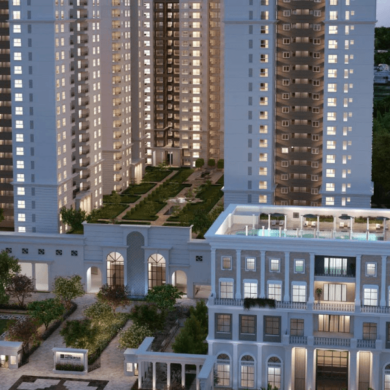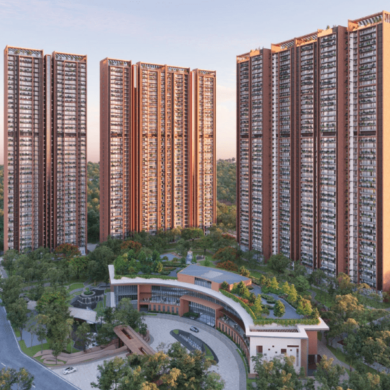
Community living in India has numerous benefits for residents – such as a strong sense of belonging and connection, meaningful relationships with neighbours, support networks that create a secure & nurturing environment, personal & possibly professional growth, success & fulfilment.
Living in a community setting offers a plethora of advantages that contribute to a fulfilling and enriching lifestyle. In recent years, this has gained immense popularity in India, providing individuals & families with a profound sense of belonging, enhanced security, and a multitude of social & recreational opportunities.
This article delves into ten key benefits of community living in India and sheds light on how it significantly enhances the overall quality of life. In the Indian context, community living holds immense significance as it nurtures a profound sense of togetherness and solidarity among residents. The concept of residing in close-knit communities goes beyond mere physical proximity – it taps into the deep-rooted social fabric of Indian society.
From individuals & couples to large joint families, community living is pivotal in fostering a supportive environment that promotes effortless exchange of ideas, skills, and resources – leading to collective growth and development. Community living in India promotes the preservation of culture and intergenerational bonding, as traditions and values are shared and passed down from generation to generation.
Table of Contents
10 Benefits of Community Living in India
-
Social Interaction and Support
When residing in a community, social interaction and support are crucial in cultivating a harmonious and fulfilling environment. The vitality of meaningful social interactions is showcased by the connections and relationships formed among community members. These interactions encompass various activities, including neighbourhood gatherings, community events, and even simple daily exchanges while passing by each other. Not only do these engagements enhance the sense of belonging, but they also lay the foundation for building trust, empathy, and understanding among residents.
In addition to socialising, community members rely on one another for support during challenging times. Whether it is extending a helping hand to a neighbour in need or actively participating in volunteer initiatives, acts of support contribute significantly to the community’s overall well-being. Through these acts, the backbone of a strong community is formed – fostering a sense of unity and enabling residents to flourish both individually and collectively.
-
Safety and Security
Residing in a community that places safety and security as its top priority offers many advantages to its inhabitants. Firstly, individuals can experience profound peace of mind, knowing that their homes and personal belongings are shielded from harm. The presence of robust safety measures – such as security gates / boom barriers, surveillance cameras, and well-trained personnel – significantly diminishes the likelihood of criminal activities. This creates an atmosphere of comfort and tranquillity, enabling residents to immerse themselves in their surroundings fully.
Secondly, safety and security within a community foster a close-knit and supportive environment. Neighbours are more inclined to watch out for one another, forging strong bonds, and cultivating a profound sense of community. This collaborative spirit promotes a positive social atmosphere where residents feel secure and connected.
Lastly, safety and security benefits extend beyond the individual level, as a secure community attracts many homebuyers and enhances property values. Prospective residents are naturally drawn to neighbourhoods that prioritise safety, resulting in increased demand and excellent investment opportunities.
-
Cost Sharing and Resource Utilisation
Living in communities with shared amenities and facilities offers a significant advantage in terms of cost sharing, ultimately benefiting residents in numerous ways. Gymnasiums, clubhouses, swimming pools, sports courts, & parks provide a broad range of leisure & fitness activities without the burden of individual ownership or maintenance.
Cost & responsibility sharing ensures that all residents contribute their fair share towards the maintenance and upkeep of these facilities, making them more accessible and affordable.
Furthermore, shared facilities foster community spirit and encourage social interaction among residents – enabling them to form connections and build relationships. This creates a supportive, vibrant living environment.
Maintenance of these facilities is distributed among all residents, ensuring they can enjoy a diverse range of amenities without the financial strain of individual ownership. Moreover, the shared facilities act as a catalyst for social interaction and community building. Residents can meet and connect with their neighbours, leading to a sense of belonging and camaraderie.
-
Cultural Diversity and Integration
Residing in a multicultural neighbourhood presents unparalleled prospects for cross-cultural interactions. Individuals from diverse backgrounds and cultures come together – graciously exchanging their unique traditions, celebrations, and customs.
This invaluable connection not only enhances the community’s collective experience but also fosters a sense of harmony among its residents.
Embracing different cultures creates a profound sense of empathy and understanding among individuals & families, cultivating a cooperative and tolerant environment. By engaging with diverse perspectives, communities can tap into various ideas, experiences, and approaches – leading to enriched problem-solving and innovation.
Moreover, cultural diversity promotes a sense of social cohesion as residents from diverse backgrounds learn to appreciate each other’s traditions and customs. This leads to stronger social bonds and a more profound sense of belonging.
By nurturing deep cultural understanding, communities encourage formation of a more inclusive & harmonious society, and unlock the potential for groundbreaking advancements and novel solutions.
-
Sustainable Living Practices
Community members can introduce innovative solutions such as recycling programs, water conservation campaigns, and renewable energy projects through collaborative efforts.
Such eco-friendly initiatives encourage residents to embrace sustainable practices in their daily lives, thereby reducing their carbon footprint and contributing to the overall well-being of the environment.
These community-driven initiatives facilitate the exchange of knowledge, ideas, and resources – creating a robust network of like-minded individuals dedicated to making a positive impact. Together, they can organise workshops, awareness campaigns, and cleanup drives to elevate environmental consciousness and inspire others to join the movement.
Community-driven eco-friendly initiatives serve as catalysts for sustainable living. By adopting a professional and proactive approach, they empower residents to actively participate in environmental conservation, promoting a greener lifestyle.
-
Recreation and Leisure
Community events and activities are vital in creating a strong sense of togetherness and belonging among residents. These serve as a platform to actively engage, connect, and cultivate lasting relationships with neighbours. From delightful cookouts to impactful charity fundraisers, these gatherings offer valuable opportunities for community members to unite and contribute to bettering their shared environment.
Not only do community events create a vibrant social fabric within neighbourhoods, but they also promote a sense of camaraderie and unity. These activities provide a platform for residents to showcase their talents, share their skills, and contribute to the community’s overall development. Whether it is a captivating art exhibition, a dedicated neighbourhood cleanup drive, or an exhilarating sports tournament, community events cater to the diverse interests of residents and promote inclusivity.
Participating in these activities makes individuals feel a profound sense of connection and value within their community. These events serve as the lifeblood of neighbourhoods, instilling a deep sense of pride, connection, and engagement among its residents.
-
Education and Skill Development
Continuous learning opportunities while living in communities can significantly contribute to personal and professional growth, offering many inherent benefits. The synergy generated by diverse individuals residing together in communities provides a unique platform for intellectual development. One of the key advantages lies in the ready availability of a wide range of educational resources and experts – enabling residents to engage in continuous learning within their immediate surroundings.
Community leaders can take the initiative to organise workshops, seminars, and training sessions that cater to various interests and skill sets. Living in communities allows individuals to benefit from mentoring and networking opportunities. Professionals residing in the same locality often collaborate on projects, share knowledge, and provide guidance to enhance each other’s expertise and careers. This collective growth mindset fosters an environment conducive to lifelong learning and professional improvement.
Consequently, individuals living within such communities are exposed to knowledge, encouragement, and support – vital for their ongoing career path. The communities they belong to act as catalysts, fuelling a passion for learning and empowering residents to unlock their full potential in both personal and professional spheres.
-
Health and Wellness
Promoting healthy habits is of utmost importance in cultivating overall wellness and enhancing quality of life. This can be accomplished in a community through various approaches – organising educational workshops, disseminating informative resources, collaborating with local healthcare providers, and more. Equipping residents with the knowledge of nutrition, physical activity, and stress management empowers them to take charge of their health.
Mutual support enables residents to share their experiences, exchange knowledge, and provide practical assistance to those facing similar health issues. This collective effort creates a sense of belonging and alleviates the isolation often experienced due to health challenges.
Regular group activities, such as fitness classes or walking clubs, result in a sense of togetherness and motivate individuals to sustain their healthy habits. Some communities promote accessible, affordable healthy food options and safe, well-maintained recreational spaces. All these initiatives are vital in ensuring the long-term enhancement of residents’ health & wellness.
-
Social Responsibility and Civic Engagement
Developing a sense of civic responsibility within a community is paramount for society’s overall well-being and advancement. It encompasses comprehending one’s duties and obligations towards the community, engaging in its activities, and striving for constant improvements. Civic responsibility necessitates residents to stay informed about local issues, participate in volunteer activities, and contribute their time & resources to benefit others.
By fostering a robust sense of civic responsibility, individuals not only enhance their personal growth but also generate a positive impact on their surroundings. They become accountable citizens who prioritise collective welfare over personal gains. Consequently, such responsible behaviour leads to heightened harmony, improved social services, and sustainable development in communities.
By embracing social responsibility and practising civic engagement, residents can contribute to their community’s overall welfare & well-being while creating an inclusive environment that promotes growth and progress of all its members.
-
Ageing in Place
Supporting elderly community members is paramount in enhancing their overall quality of life. Living in a community presents a unique opportunity to establish strong social connections and ensure the availability of necessary assistance. To achieve this, community members must be fully aware of the specific needs and challenges faced by the elderly population, including physical limitations, cognitive decline, and emotional well-being.
Ageing-friendly infrastructure is vital in ensuring the well-being of older residents within a community. At its essence, ageing-friendly infrastructure encompasses a range of elements – including accessible transportation, safe and pedestrian-friendly streets, open spaces, well-designed housing structures, and social gathering spots. Prioritising these features is crucial to create an ageing-friendly community that empowers older individuals to maintain their independence and actively engage in the society.
In addition to these efforts, communities establish volunteer programs within the community that can be immensely beneficial to older people. These programs allow residents to contribute their time and skills towards assisting the elderly with daily chores or providing companionship. By doing so, they alleviate the burden on older individuals, and create a sense of purpose & fulfilment for themselves.
Conclusion
With its diverse culture and rich heritage, India provides an ideal environment for nurturing communities that can thrive collectively. Benefits of community living in India include social cohesion, optimum sharing of resources, ideas, & opportunities, promoting interpersonal learning, celebrating diversity, and forging meaningful relationships.
By promoting community living, we can effectively address pressing challenges such as safety & security, privacy, infrastructural lacunae, lack of amenities, urban loneliness, and more. Additionally, it cultivates a sense of belonging and strengthens social bonds within neighbourhoods & cities. This not only enhances individual well-being but also contributes to the overall progress of society.
FAQs
1. What is community living?
Community living is a gated campus with security, in which residents share common spaces such as amenities, gardens, parks, areas for celebrations & festivals, supermarkets, clinics, and more – creating a sense of togetherness and collaboration.
2. Why is community living gaining popularity in India?
Community living is gaining popularity in India due to the increasing need for social connection, shared resources, modern amenities, and a more holistic & sustainable lifestyle.
3. What are the social benefits of community living?
The social benefits of community living are emotional support, shared responsibilities & costs, a strong sense of community, companionship, and mutual assistance – creating a supportive environment for residents.
4. How does community living contribute to cost-effective living?
Community living contributes to cost-effective living through shared expenses & resources, economies of scale, reduced individual costs, and more.
5. What security measures are in place in community living setups?
Security measures in community living setups are surveillance systems, 24/7 security personnel, gated campus, collective safety efforts, and a sense of safety among residents due to the close-knit community.
6. How does community living promote cultural diversity?
Community living promotes cultural diversity by exposing residents to diverse cultures and traditions, fostering cultural exchange & understanding, and a sense of unity in diversity.
7. Are there educational opportunities within community living setups?
Yes, educational opportunities within community living setups include learning initiatives, collaborative educational programs, skill-sharing, and knowledge transfer among residents.
8. What are the potential challenges of community living?
Potential challenges of community living are conflicts over shared costs, disputes between neighbours, balancing individual preferences with community rules, and the need for effective communication and conflict resolution strategies.
9. How does community living contribute to sustainable living practices?
Community living contributes to sustainable living practices by encouraging shared resources, reducing environmental impact, driving large-scale eco-friendly initiatives, and promoting green practices.
10. What are the benefits of living in a community?
The benefits of living in a community are social support & companionship, shared responsibilities & mutual assistance, access to communal resources & facilities, enhanced sense of security, and opportunities for cultural exchange & diversity.
11. What are the benefits of the community system?
The benefits of the community system are: 1. Efficient resource utilisation through shared services 2. Improved communication and collaboration among members 3. Collective problem-solving and decision-making 4. Strengthened social bonds and a sense of belonging 5. Enhanced community resilience and cohesion
12. What is the greatest benefit of the community?
The greatest benefit of the community is the sense of belonging and support it provides, leading to an environment where residents feel connected, valued, and part of something larger.
13. What are the five needs of the community?
Five needs of the community are: 1. Social needs: nurturing relationships and connections 2. Economic needs: shared costs of common resources 3. Environmental needs: sustainability and a clean, safe environment 4. Cultural needs: preserving and promoting diverse traditions 5. Basic needs: access to healthcare, education, and essential services.
14. What is the purpose of the community system?
The purpose of the community system is to create an organised and collaborative environment that facilitates efficient resource allocation, enhanced social interaction, and shared decision-making for the well-being of residents.
15. What are the benefits of participation?
The benefits of participation are increased sense of belonging and community, opportunities for personal growth, enhanced social connections and networking, contribution to community development and well-being, shared responsibility, and a stronger, more resilient community.










